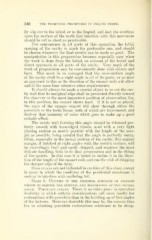Page 682 - My FlipBook
P. 682
340 THE TECHNICAL PROCEDUEES IIST FILLING TEETH.
ily slip out to the labial, or to the lingual, and that the overlaps
upon the surface of the tooth that interfere with this movement
should be cut as short as practicable.
For convenience in all parts of this operation, the labial
opening of the cavity is much the preferable one, and should
be chosen whenever the final results can be made as good. The
manipulation in this preparation becomes especially easy when
the work is done from the labial, on account of the broad and
direct approach to all parts of the cavity. Very much of the
work of preparation may be conveniently done with chisels and
burs. This must be so managed that the cavo-surface angle
of the cavity shall be a right angle in all of its parts, or as near
an approach to this as the direction of the enamel rods will allow
and at the same time subserve other requirements.
It should always be made a special object to so cut the cav-
ity wall that its marginal edge shall be presented directly toward
the observer at the most important position of observation, for,
in this position, the cement shows least. If it is not so placed,
the seam of the opaque cement will show through either the
porcelain or the tooth tissue, both of which are translucent, and
destroy that harmony of color which goes to make up a good
esthetic effect.
The cavity wall forming this angle should be trimmed per-
fectly smooth with keen-edged chisels, used with a very light
planing motion as nearly parallel with the length of the mar-
gin as possible, being careful that the angle is perfectly sharp.
Often, esijecially in the incisal portion of the cavity, this enamel
margin, if finished at right angles with the tooth's surface, will
be exceedingly frail and easily chipped, and requires the most
delicate handling, both in its final preparation and in the fitting
of the matrix. In this case it is better to iueline it in the direc-
tion of the length of the enamel rods and run the risk of chipping
the sharper edge of the inlay.
Gold inlays are not indicated in cavities of this class, except
in eases in which the condition of the peridental membrane is
such as to interfere with malleting foil.
Class 4. Cavities in the proximal surfaces of incisors
WHICH do require THE REMOVAL AND RESTORATION OF THE INCISAL
ANGLE. Porcelain inlays. There is no other place in operative
dentistry in which esthetic considerations call more loudly for
restorations with porcelain than in the building up of lost angles
of the incisors. However desirable this may be, the success thus
far in retaining porcelain restorations continues to be disap-


